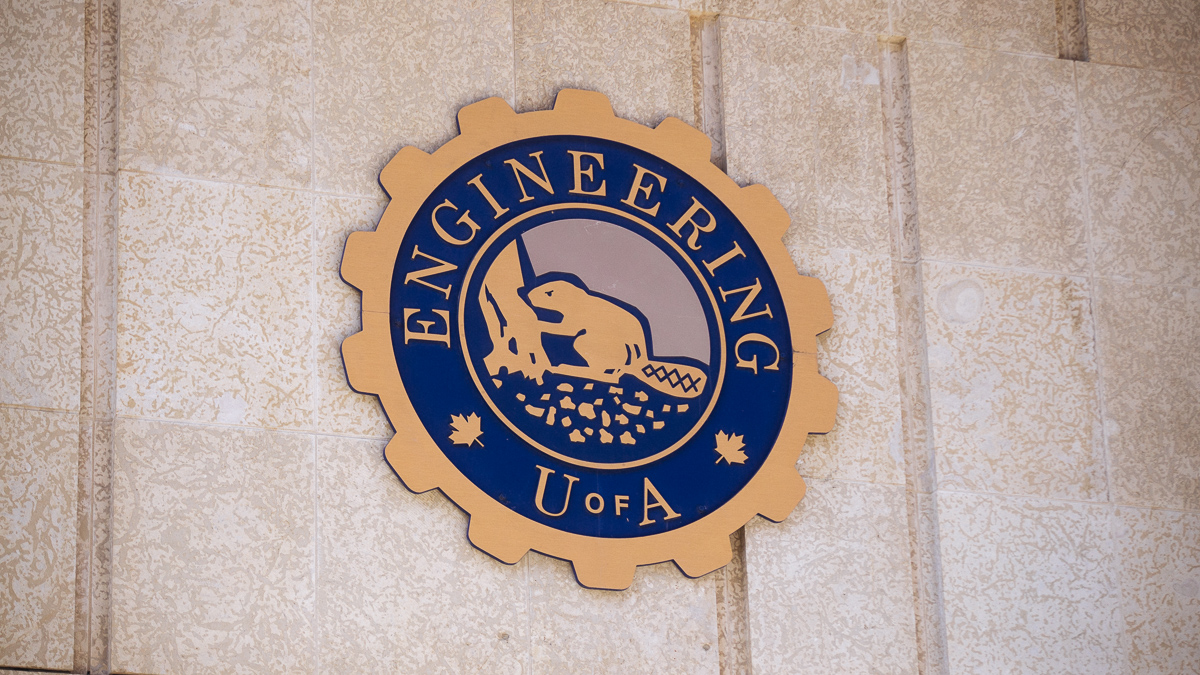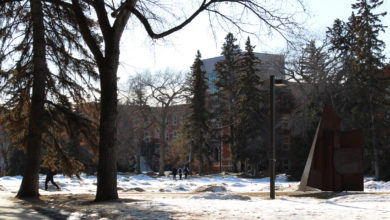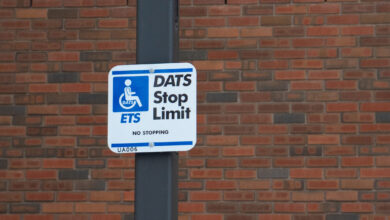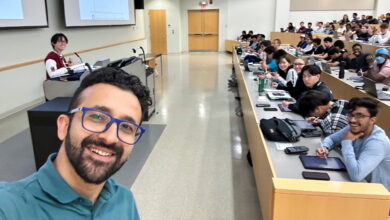SU Elections 2025 Q&A: Vice-president (student life)
The 2025 Students' Union election has four candidates running for vice-president (student life): Saim Khokhar, Nikka R. Pakhomova, Ramish Raza, and Logan West.
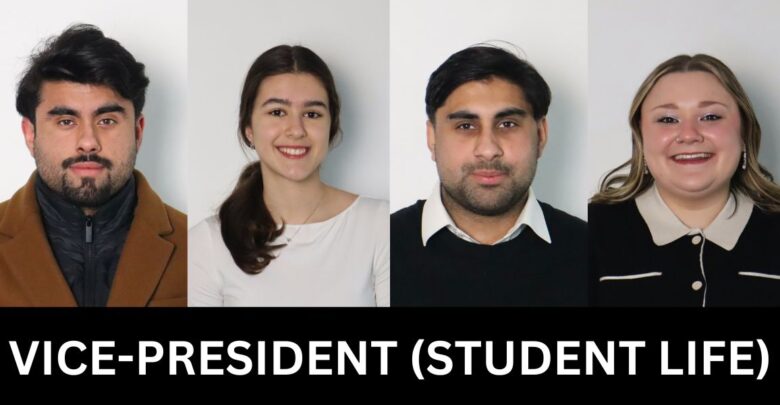 Kathryn Johnson, Gabriella Menezes
Kathryn Johnson, Gabriella Menezes The University of Alberta Students’ Union (SU) vice-president (student life) (VPSL) is responsible for non-academic advocacy regarding issues that impact students. The wide range of responsibilities of the VPSL can include mental health and well-being supports, advocacy for those living in residence, and more. The VPSL is also responsible for many programs and events put on by the SU.
There are four candidates running in the VPSL race:
- Saim Khokhar, a fourth-year student in combined sciences and education
- Nikka R. Pakhomova, a first-year astrophysics student
- Ramish Raza, a fourth-year political science student, co-president of the International Students’ Association (ISA), and 2024–25 arts councillor on the General Faculties Council
- Logan West, a fifth-year student in film studies and women and gender studies, vice-president (outreach and events) of the Organization for Arts Students and Interdisciplinary Studies (OASIS), and 2024–25 GFC arts councillor
The following interviews have been edited for brevity and clarity. Candidates were given 1 minute and 30 seconds to answer each question.
Why have you decided to run for VPSL?
Saim Khokar: I’ve been involved in a variety of roles since my second year. I started out as the vice-president of finance of the Augustana Students Association (ASA). I’ve been the editor-in-chief of the [Dagligtale], treasurer for the South Asia Club, and this year I’ve been a resident assistant (RA). One thing that I’ve learned in each one of these roles is that students have a variety of concerns regarding community and wellness advocacy, for example, or student engagement and communication. One of my strengths is I can bring many people together. For example, for a small institution such as Augustana, in my second year when I was the vice-president of finance at the ASA, two of the executives struggled to get an adequate number of people to support a survey. I was able to get 50 people within two hours … when they were barely able to produce 10 people to engage with the surveys. I’ve been able to continue that work even in my role as a treasurer for South Asia Club. So that’s why I’m running — I believe that the struggles that students have had and the strengths that I have are best tailored to this position.
Nikka Pakhomova: As a first-year student, I had my first Week of Welcome (WoW) and my first events here. I feel like I want to be the one who organizes those events for the next generations. Especially for next year, because there should be more events rather than just WoW, and people should remember and collect memories from university, not only from WoW but from lots of events. As an international student, I have noticed some issues regarding inclusivity and the voices of minorities, which I think should be addressed and I would like to address them.
Ramish Raza: It all started back in 2021 when I joined this university. I started to work as a RA in East Campus. This is where I built connections with folks from different demographics. I built that trust and I got the ability to understand the concerns of students from different demographics. And then I got involved in governance. I served as a VPSL for the ISA for one year. I’m currently the co-president for ISA. I also represent arts in GFC. So this is where I had this courage for the SU because I want to have a closer look at how these things work and I’ve already had that experience. The reason that I’m running is that I have felt that there are some gaps within the SU in terms of advocacy for students, let’s say in tuition and affordability. I want to utilize my experience and my expertise [towards] the concern that I’ve heard from students across the university, across the campuses, and utilize that experience and be a voice for students, especially in concerns related to student life.
Logan West: When I decided to run for VPSL, it came down to me having to ask myself two questions. The first question was, “why do I want to run?” I want to run because I want to help students. That’s always been the impetus for getting involved on campus, and I want to use the voice I have to advocate. I’ve seen year after year how rising costs, inadequate resources, and a general disconnect between the student body and student governance have made a lot of students feel like their voices are unheard and their needs aren’t being met. So I felt called to run again this year to better things. The second question I had to ask myself was: “how can I make the most tangible change on campus, and how can I utilize the strengths that I have as a student leader that I’ve cultivated over the last year to do the best work?” As the OASIS vice-president (outreach and events) and having sat on Student Group Committee, I’ve had a lot of overlap with the VPSL portfolio. More broadly, my concerns on campus tend to be non-academic in nature: sexual and gender-based violence (SGBV), the period equity initiative, safety concerns, and accessibility issues. So in that sense, [this] portfolio felt like a natural fit.
What would you say are the three main takeaways from your platform?
Khokhar: The three main takeaways of my platform would deal with student groups, residence, and community and wellness advocacy. For student groups, I want to be able to honour my previous roles in both newspaper and student clubs through providing them greater benefits that we noticed were sometimes lacking. For example, we don’t have a certificate of insurance for student clubs because there are some complexities for that. Something that we could do for specific student groups that have consistent financial records year over year is provide them with an automatic certificate of insurance up to an agreed upon limit. The other area would deal with residence. Maybe you’ve heard that some students are not very satisfied with the maintenance or meal plans that they are offered. What I was thinking is that we might have a system where the cost of the residence dorms can be reduced and transferred over to the following year if there are issues regarding the maintenance of their rooms. The other area that we could deal with regarding meal plans is we could have food ambassadors that come together from each of the dining halls across the U of A campuses, who could help us have a public disclosure of the financial records so we could see where money might be overspent.
Pakhomova: The most important takeaway of my platform is ACB, previously known as Equity, Diversity, and Inclusion (EDI), which stands for Access, Community, and Belonging. Regarding access, as a university, it’s a top 100 university in the world. Access for everyone should be something guaranteed for everyone, no matter where you come from, your religion, or any other aspect of you. Access should be guaranteed for everyone in the same way. For community, I have noticed a difference for people who live on campus and off campus, and I want to make something for people to be attached to on campus rather than just being in classes.
So they finish classes at the end of the day and giving them an option of an event or something to attend to connect with peers, with other people, or having something else to do rather than just going home — I feel like it’s super important. Also trying to strengthen the U of A community by connecting campuses, so Augustana and Campus Saint-Jean (CSJ), and connecting with the ASA and L’Association des Universitaires de la Faculté Saint-Jean (AUFSJ). So doing that and creating some events for everyone by connecting campuses together and connecting people who live inside and out of campus. And finally, belonging. I was thinking that it’s also something that should be addressed as an international student for different voices and minorities.
Raza: Campus safety, affordability, student well-being, and community outreach. So in terms of campus safety, unfortunately, we saw there were some recent episodes. [In the] the Indigenous Students’ Union (ISU) lounge, someone got assaulted. There was a reddit post about HUB mall, and there was a Muslim woman who was harassed in the LRT. So I think campus safety would be my first priority. Also affordability struggles right now. Campus Food Bank (CFB) has such an increased demand which shows that student are struggling. And on top of that, the university is increasing the tuition. So that’s just unimaginable, and rent is increasing. Residence rent increased significantly last year after their rent rationalization policy. This is where I want to bring in my advocacy to see what we can do about rent, especially in residence because I live in residence. I can really see that buildings are empty. And other than that, I need to work on [SGBV] and the mental and physical health of students. I also want to work in community outreach. That would be working with student groups because a lot of updates are coming in for student groups. In addition to this, I want to expand our events to cater the needs of all students from all demographics.
West: My first platform point is enhancing safety and well-being on campus. Safety has been a hot topic this year for a lot of students, and I think it comes down to the SU holding the university accountable. As well as getting a better sense of what policies are in place to keep students safe, and seeing where there are areas for improvement that we can make recommendations on. In terms of well-being, that’s broader and reflects three main areas — mental health, physical health, and sexual health. This point also includes wanting to lead an initiative that takes a comprehensive approach against sexual and gender-based violence on campus. My second point is revitalizing indoor and outdoor spaces — improving ONEcard access between buildings, accessibility inside and outside the classrooms, and optimizing student study spaces indoors and outdoors to make the learning experience better for all students. My last point is building trust and strengthening outreach. I want to address the disconnect between the larger student body and the SU, as well as between the SU and the Student Representative Associations (SRAs) we represent, by working collaboratively on key issues and strengthening outreach. Not just through a physical presence on campus, but also via social media and other channels.
The ISU has raised safety concerns after a student was assaulted in the ISU lounge. How will you work to ensure the safety and security of students on campus?
Khokhar: I think that since I can’t … receive access to specific details regarding the assault that occurred, given my limited knowledge, what I would like to do is have the people that are part of the Safewalk program for [the U of A Protective Services] (UAPS), maintain some level of presence. Not a direct presence, but a presence around the area, just to ensure that the people who are there for for genuine reasons are able to access the space. But at the same time, there should be a confrontational approach regarding the individual or individuals who might or have committed the assault.
Pakhomova: Well, regarding the belonging aspect of my platform, I believe that the U of A is already doing a great job, recognizing the territory that we are on and giving those minorities a voice. However, for those security aspects, it’s for sure a concern that still arises to this day, and I would like to address that by actually talking to people and being there for those voices, for those minorities, and giving them a voice at council. They should have an Indigenous representative at the council, the same as for international students. Regarding this specific aspect, students should feel secure and I would like to address that by talking to them, actually hearing them and their issues, and really giving them that sense of belonging to the community of the U of A by just making sure you feel safe.
Raza: I’m aware of the concerns and I think that’s unfortunate that has happened, especially when the ISU was asking for ONEcard access to the lounge and it did not happen, until that unfortunate incident happened. So I plan to follow an intersectional approach. My safety plan is built on three main points and I want to first hear from students, of course. The first point would be to consult with the ISU what they think is the best approach. And, apart from that, I think I want to work on promoting the SU services that are already in place, like Safewalk. I also want to see into the possibility of having compassionate training for UAPS officers. Because they are uniformed people and they’re on the payroll of the university, they need to have some sort of training given to them so that they know how to deal with students. But my main priority would be to use our SU resources, like Safewalk again. I want to circle back to consultation because you want to hear from folks who are directly impacted by these incidents. Overall, I have a very detailed program on safety and that would be the first part of my platform. Again, there are other things, encampment issues and all that. So we want to be consulting students with this and get that feedback and build a strategy.
West: As I mentioned, safety on campus has been a hot topic for a lot of students. There’s a general distrust from the student body in terms of how their safety is being protected, and how we’re being kept safe when there are threats. I was there that day, near the ISU lounge, and so I heard about it very soon after the assault occurred. I was really concerned, I have a lot of friends who are there. I spend a lot of time in the space myself, and I’m passionate about the work that they do. So to know that they had somebody come in and do that to a student raised a lot of red flags for me. It seemed there were delays in installing a ONEcard reader in that lounge and that the voices of Indigenous students and Indigenous student leaders, who had raised concerns for months, weren’t being heard. I think when it comes to safety, we have to have a very nuanced and collaborative conversation with lots of stakeholders. A lot of students have different opinions on how we should address it, and no decisions should ever be made lightly. Furthermore, in collaboration with the ISU on their lounge space, we need to take a lateral approach rather than a hierarchical one — bringing them into the conversation and working alongside them, not over them.
As VPSL, what initiatives will you be taking to foster community on campus? Furthermore, how do you plan to promote your events and other initiatives?
Khokhar: For community and wellness, there are a couple things that I want to do. I feel as though that we lack an interconnectedness, given how big our campus is, and I’m from Augustana which is a satellite campus of the U of A. It would be nice to have something that connects all student governments through some sort of mascot like we have for our sports teams. That way, we could add a bit of cheer to our community as a whole. The other thing I would like to do is use funds from our current budget, so not tapping into excess funds, [and] we could have something like friendship bracelets. But they wouldn’t be intended with the idea of friendships. They’d be more so to get people connected to their passions. So you could say if somebody’s from the computer science stream, they could have a bracelet that has computer science on it. Somebody from English could have something that says English on it, and they’ll be able to be exposed to more students that they might even pass by and have a chance to indulge in a conversation about what got them to the program, what they’re interested in it. You could even start a trend with it where we could encourage them to do it as a thing just for the sake of doing as they walk by other people.
Pakhomova: Well, one of the ideas I have in mind is an event, a cultural week called Around the World Week. So, it would be for each day of the week, one continent that would be on the Main Quad, for example, with performances, dances, and food from like a full experience of that culture from every continent. Broadening Canadian students’ perspectives on international students and international students’ perspectives on different cultures. Since there are around 9,000 international students at the U of A, it’s important to introduce them to different cultures and to introduce Canadian students to all different cultures since they are surrounded by them. And to also strengthen the community by giving the international students a day of representation and the voice that they deserve. Also, allowing everyone to connect around different cultures and getting to know people. That’s just one of my ideas, and there might be more actually.
Raza: It comes back to collaboration. When it comes to promoting events I would work with our SRAs, our faculty associations (FA), and regional and cultural associations. So first of all, we already have collaborative events. I did, with the ISA, the Indigenous Celebration Week (ICW) with the ISU. But I want to take a further step, and I want to see how we can collaborate with our cultural and regional associations because they matter to us as well. So, one part is to collaborate with them and then of course, collectively promoting our events. So I would utilize SU resources like our Instagram, and I would see how sustainable it is to put posters on campus. So there will definitely be some things that I will work with my staff on. But you know, one important thing for promoting those events is to be visible. So I will be visible at all those events as much as I can, making sure that it’s not impacting my work of course. There would be priorities, but being visible at those events and continuing to collaborate with the ISA and ISU and maybe looking into the possibility of expanding those initiatives like International Students’ Day (I-Day). Maybe expand [ICW]. But again, consulting with those folks who are taking care of those events because I believe in consultation and I also believe in power balance. What that means to me is that you need to ensure that you’re not overtaking someone’s authority.
West: So the first initiative that I’m passionate about is installing some sort of a task force to address [SGBV] on campus. In the 90s, this task force was formed and the recommendations that came out of it were to establish a campus Sexual Assault Centre (UASAC). Considering that we haven’t had much progress on the matter since the 90s, it tells us that it’s time for a change and [it’s] time to look at those policies again. That will be a long-term goal over the year, working with the Dean of Students (DoS), the UASAC, various stakeholders, and experts on campus and in the community. It’s an initiative I’m very passionate about getting off the ground. Another initiative I’m passionate about is more data collection, whether through the Perks surveys or meeting with students, specifically to address key concerns for building accessibility — not just maintenance, but also ONEcard access and internal pedways. In order to reach students, I really do pride myself on being a social media lover, and I want to use it to break down communication barriers. I want to explain things more accessibly and connect consistently in person with SRAs, FAs, and residence in a more genuine and friendly manner. This will help build relationships so that when we call on them to mobilize, whether by signing a letter or supporting an initiative, those connections are already in place.
CORRECTION: This paragraph was updated at 12:52 p.m.. on February 24, 2025, to say “internal pedways,” not “internal headways.” The Gateway regrets this error.
How would you foster community and student life at CSJ and Augustana campus, in addition to North Campus?
Khokhar: I understand that a lot of the issues that Augustana faces are similar to CSJ. I have actively spoken to some students, because of the people that I know have mentioned similar concerns, and I think one of the biggest areas that we’re all interconnected with is probably residences. So I feel that that in and of its own self would likely be the way to address concerns that affect every U of A student living in residence unanimously.
Pakhomova: For sure what I want to do is definitely connect all of the campuses together. So it would be like Augustana would have their own events ,and then CSJ of course they’re going to have events. But instead of students from different campuses coming to North Campus for some events, it should also be the other way around. So, students from North Campus should have events [happening] in CSJ or in Augustana that they’re interested in. Huge events, actually, that are worth going to, will just strengthen the communities between all of them. At CSJ, having the option of doing it in French is also like a French immersion in a Canadian country that has both official languages, which is super important. And for Augustana, knowing that it’s also a big campus, it has a lot of opportunities and events that can be done there to strengthen the campuses altogether as a community because it’s a community of Alberta as a whole.
Raza: I think this has been a demand. This has been an issue for students from CSJ and Augustana, all the students don’t feel well represented and included in our events. I have been to Augustana for ISA and this is where I realized, and this is where I got feedback from students. I realized that they feel so lonely, especially during winter break because there’s no programs and services get shut down. I had a similar idea of meeting with the CSJ President for the FA, and this is where I’ve gotten feedback on how can we collaborate, and how can we make students from CSJ and Augustana feel more welcome. So for Augustana, I’ll look into the possibility of having some events during those breaks. Now that there’s a shuttle service maybe looking into the possibility of collaboration and [bringing] students here on campus. The main focus would be to have some events there because they matter and there should be services available to them. Same as the goal for CSJ, we need to ensure that we’re welcoming and we’re following an approach that is bilingual so that everyone feels welcome. So again, consultation with those two associations and getting their feedback and making sure that this is a collaboration, and that it’s not just the SU taking over their authority. I think that this is where I will put my perspective and my expertise.
West: I think the work that the ASA and AUFSJ do for their students is already doing a lot to foster that community. I genuinely think that those FAs understand the needs of their students and their student body better than the SU ever could. They’re there every day, that’s their lived experience, that’s their lives, and they’re connecting with those students. As a member of the SU, I would seek to collaborate with those organizations in order to assist, rather than step over the initiatives that they already have and see where we can provide assistance and help. I think being a presence, whether by meeting in-person at least once per trimester in the summer, fall, and winter is important to connect with the student body, and strengthen those relationships. Social media is a way to reach out and connect with students more broadly, but I think it comes down to fostering those relationships with those associations. That’s the starting point.
How do you plan to stay engaged with students throughout your term?
Khokhar: One of the things that I brought up earlier is to implement the idea of the mascot. At the same time, I would have to host several large scale events throughout the year where people can actively be involved. Whether it’s through utilizing the strengths of students who might be in the arts and who might want to showcase their talents of let’s say singing or songwriting and the like. I think what I’d likely to do is create these mixers where we bring in professionals and students together so that there’s a bit of an incentive for students to continue coming, and hence I can retain my ability to consistently and constantly engage students over and over again.
Pakhomova: Regarding Augustana and CSJ, I of course, plan on visiting it constantly. Planning events there will also make me be there a lot more. And of course having office hours is super important for people to just come up to you and be able to talk about their concerns, their ideas for the events, projects, or their issues no matter what it is. They should have the access and opportunity to talk to someone who is going to listen to them, who’s going to address their issues, and I feel like that is super important in all campuses. I want to be that person that they can just directly talk to, have office hours with and just have that way of connecting with them. Not through intermediaries, where you don’t really feel like it’s a direct connection and you don’t really feel listened to. I really want to be that person that they can go to knowing that they’re going to be listened to.
Raza: Our SU represents more than 30,000 students currently. So I think it’s really important for students to know who their VPSL is because they pay a good amount for the SU fee. It’s traditional to do office hours, but I want to do it differently. I want to have it maybe on different days, in different buildings. I want to also look at the possibility of having office hours just for folks who live in residence. I won’t call them office hours though, I’ll call them coffee chats, just to make it a little informal and to take any power difference and rule it out. I said earlier that showing up to events is what our campus is all about. Showing up to events and letting people know that I’m the VPSL, and if you have any concerns, feel free to reach out to me. So showing up to events and then getting feedback from students, and office hours that we’ll call coffee chats and, giving regular updates. I know the SU gives regular updates on their Instagram but maybe on my own Instagram, because if I’m using it for my election campaign, why not use it once I’m in office. Why not use it to give updates, on you know “this is what I’ve been doing.” I want to get their feedback because at the end of the day, students are the ones who matter the most, not this portfolio.
West: Something I pride myself on is being very involved on campus already in my role in student governance, as well as being a full-time student and spending my nightlife on campus. I like to attend events hosted by other faculties and departments. I enjoy being involved in many different ways, and in my off hours, you can usually find me at Dewey’s, at karaoke, or near campus spending time with friends. So, I think being a presence, not just in a formal setting, but in an authentic and genuine capacity as somebody who is also a student like everyone else, is key to engaging with students on a more personal level. I also think utilizing my social media presence and growing a larger following simply by posting fun things and connecting with students through polls is another great way to be someone people recognize, know, and want to connect with.

